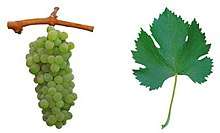Antão Vaz
| Antão Vaz | |
|---|---|
| Grape (Vitis) | |
 | |
| Color of berry skin | Blanc |
| Species | Vitis vinifera |
| Also called | Antonio Vaz |
| Origin | Portugal |
| Pedigree parent 1 | Cayetana |
| Pedigree parent 2 | João Domingos |
| Notable regions | Alentejo |
| Formation of seeds | Complete |
| Sex of flowers | Hermaphrodite |
| VIVC number | 493 |
Antão Vaz is a native Portuguese white wine grape variety.[1] Genetic testing has shown it to be a cross of the white Cayetana blanca (through which it is a grandchild of Hebén) and the almost unknown red João Domingos, which is thought to be extinct in its native Portugal.[2][3] It is grown primarily in the Alentejo region, with additional plantings around Lisbon and in the Península de Setúbal. It is vigorous and productive, and requires a hot climate. The thick skins on these large loosely packed grapes enable them to withstand high heat and dehydration. It produces complex, light yellow wines with citrus and tropical aromas. Depending on the time of harvest, the wines can range from very acidic to ripe and alcoholic.[4][5]
References
- ↑ "ANTAO VAZ". Vitis International Variety Catalogue VIVC. Julius Kühn-Institut - Federal Research Centre for Cultivated Plants (JKI), Institute for Grapevine Breeding - Geilweilerhof (ZR). August 2017. Retrieved 2017-09-17.
- ↑ LACOMBE, T.; BOURSIQUOT, J.M.; LAUCOU, V.; Di VECCHI-STARAZ, M.; PEROS, J.P.; THIS, P. (2013). "Large-scale parentage analysis in an extended set of grapevine cultivars (Vitis vinifera L.)". Theoretical Applied Genetics. 126: 401–414.
- ↑ Frank Massholder. "João Domingos". lebensmittellexikon.de. Retrieved 2017-09-20.
- ↑ "Antão Vaz". Instituto Da Vinha E Do Vinho. Ministério da Agricultura, Florestas e Desenvolvimento Rural. Retrieved 2017-09-20.
- ↑ "Antão Vaz". Wines of Portugal. 2010. Retrieved 2017-09-20.
This article is issued from
Wikipedia.
The text is licensed under Creative Commons - Attribution - Sharealike.
Additional terms may apply for the media files.